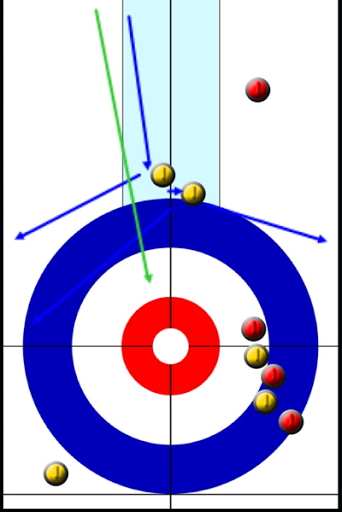Finally wrapping up this article as I sit in a quiet Calgary arena, awaiting the historic Brier Pre-qualifier between Yukon and PEI. One day I can bounce my grandchild on my knee and say I was here. At which point he/she will likely poop in their diapers.
The Saddledome is mostly empty, save for a pre-qual pre-preparation, held by CCA Csar Director, Warren Hansen.

Heeding the advice of Tiger's mom, Warren wears red for strength
Rather than struggle with the decision of whether I can bring myself to bet on PEI at -454 against Yukon, let me get back to the big event last weekend and cover some of the stranger decisions at the Scotties...
Play-off - 3 vs 4: Saskatchewan vs Team Canada
Stefanie Lawton reached this same position in her three previous Scotties as a skip, and finally pulled out a victory. She took a conservative approach to the week and it enabled her to win one more game than her usual result. Totals for her round robin games fell below 12.5 points for almost the entire week, leading websites to drop her games to 11.5 points, a number usually seen in men's events. I'm not going to challenge her strategy, or question her continuing to curl with a possibly passed her prime third, rather than inject some youth like others chasing the Olympic gold have. She remains a good under the radar gamble, and for that I will keep quiet.
One interesting comment during the 9th end. Lawton is tied 5-5 with hammer. Broadcaster Russ Howard mentions Stefanie doesn't want to give up a steal in this situation. Possibly a slip from the veteran skip. The end had already developed to the stage that a blank was unlikely. At this stage, the team with hammer should be agressively attempting a deuce (Win Expectancy of 86%), even at the risk of a steal. Lawton will almost always have some shot to score one with her final stone and even if Homan steals, she has hammer in the final end with a chance to score two for the win.
Semi-Final: Saskatchewan vs Alberta
Lawton takes on Val Sweeting, who knocked her out of the 3-4 game in last years Scotties. Unfortunately for the hometown fans in Moose Jaw, it's the same result. Some odd calls during the game:
8th end, AB up 6-5 with hammer.
On Lawton second Stephanie Schmidt's last shot they choose to hit an AB rock in the twleve foot to sit 2, open at the back of the rings, rather than put up another centre guard. This is an incredibly conservative call that I haven't seen since the days of Connie Laliberte peeling guards when behind. The problem is, a successful hit will leave a simple double, and she's likely to head into the next end with the same score. Mind boggling. You don't have to be a master at analytics (like Charles) in order to know this is a bad decision.
Strangely, Sweeting forgoes the double attempt and instead tries a freeze. She's not risking much, there are no guards and little apparent trouble at this stage. In the 9th end, this would be a wrong decision. Here it surpises me but likely not a significant mistake.
10th end: SK down 7-5 with hammer.
On Lawton's first she chooses to draw around the red corner to sit two buried. Some posters on CurlingZone suggested a split. Difficult not to leave a double, perhaps even a triple, but good chance of 2. Val chooses to play a corner freeze rather a runback, and nearly gets shot stone. Stef still has draw for 2. She's unable to get a good path and comes up light.
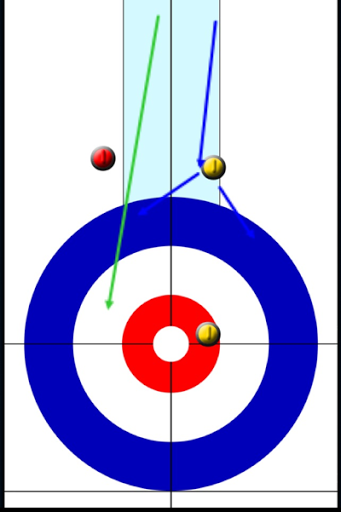
Lawton is Yellow
I don't mind the come around. I expected Val to play the 6 foot runback on her guard, perhaps so did Stefanie. The draw was very risky and could have left Stef a chance for the win. The decision Lawton has to make is whether you want to entice a draw from Val and increase the chance to win the game here or split and more likely score two. You can make an argument for both. A great shot by Sweeting that brought greater risk with less room for error, but she was confident in her weight and made the shot. I expect many mens teams would have played a runback in that situation.
Finals: Alberta vs Manitoba
Val Sweeting incorporated a Lawton strategy in her game with Jennifer Jones. Conservative.
In the 3rd end, tied 2-2, MB with hammer, AB sits 1 on the top four foot and Val decides to peel the corner guard on second stones. She mentions she's guessing on ice. At this early stage of the end, less critical to put up a perfect centre guard than to, at the very least, have one. Jennifer then replaces the corner guard.
In the 5th end, AB is down 3-2 with hammer. Val immediately calls for a freeze/tap with her first shot (green line). Sitting second shot and facing a longish guard, not sure why she didn't look at trying to remove the MB stone (blue line). She would roll open and Jennifer would hit, leaving her a final shot for 2 points. She needs to move the MB stone to get shot, might as well move it to the back twelve. Appeared there was enough curl.
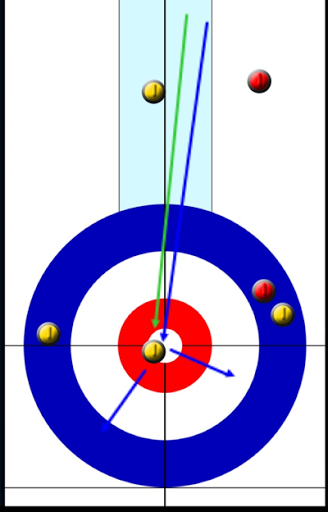
Sweeting is Red
The end result, Val's draw over curls and sits second shot. Jennifer draws on top and Val attempts a flat double off the MB stone at 9 o'clock, moves the shot stone far enough for one, almost scoring two.
In the 6th end AB is tied 3-3 without hammer and again thinking of peeling corner guards (green line). Third's first and sitting three. They correctly decide to play a guard (blue line) instead. Why peel a guard that is not likely to come into play this late in an end and which also may be cutting of a potential draw to the button later on?
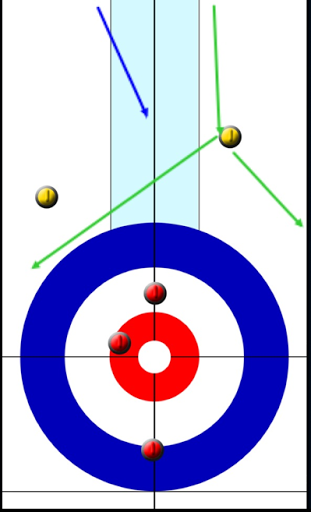
Jones is Yellow
7th end: 4-3 for MB, AB with hammer. This end may have decided the winner. AB third Lori Olson-Johns is an inch short on her draw earlier in the end, now sitting second at 2 o'clock.
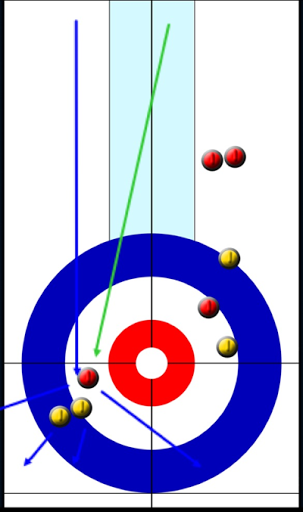
Sweeting is Red
Val plays a freeze to the open side and Jennifer decides to freeze again (green line), rather than peel the rock out (blue line). Even if Jen looses her other rocks, Alberta is left with a draw for 1. As it turned out, Jen's didn't curl enough and Val had a makeable shot for 2, but she missed it again by a fraction of an inch. AB takes one.
9th end. AB down 5-4 with hammer. Val seemed to be playing runbacks (green line) with the intention of blanking, but it was unlikely that late in the end. Rather than running back the MB stone on Lori's first shot, to try and sit two, (which was more difficult than it appeared) perhaps they could have tried a soft weight tap and would have sit frozen on two stones (blue line).

Well done Jennifer. Team Canada again and Sweeting a bridesmaid for the second straight year.


